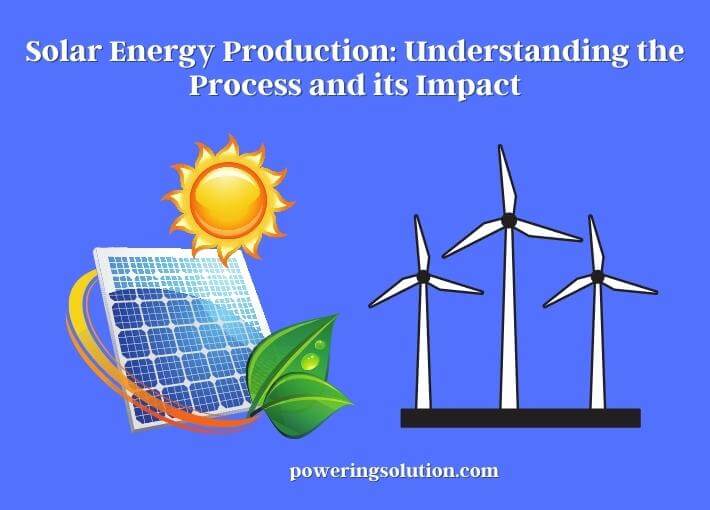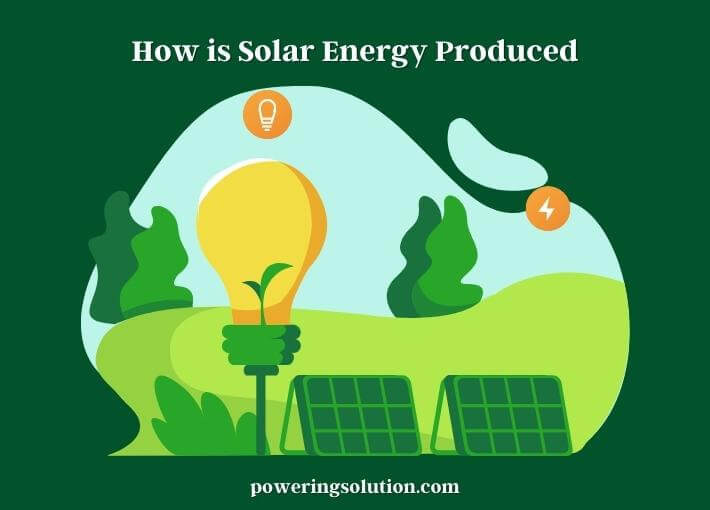Renewable energy sources, such as solar energy, are becoming increasingly important as we strive to reduce our carbon footprint and protect the environment. Solar energy production involves harnessing the power of the sun’s rays and converting them into electricity through the use of solar panels.

As the technology for solar energy production continues to improve, more and more people are turning to this clean and sustainable source of energy for their homes and businesses. Here, we will explore the process of solar energy production, its impact on the environment, and the benefits of using solar energy.
How is Solar Energy Produced?
The process of producing solar energy involves the conversion of the sun’s energy into electricity through the use of solar panels. Solar panels are made up of photovoltaic (PV) cells that absorb sunlight and convert it into direct current (DC) electricity.
The PV cells within a solar panel are made up of layers of silicon and other materials. When sunlight hits the solar panel, the energy from the photons in the light excites electrons in the silicon atoms, causing them to flow through the material. This creates a flow of electrical current that can be captured by wires and used to power electrical devices.
Once the DC electricity is produced by the PV cells, it must be converted into alternating current (AC) electricity to be used in homes and businesses. This is done through an inverter, which takes the DC electricity and converts it into AC electricity.
The AC electricity produced by the solar panels can be used immediately, or it can be stored in batteries for later use. If there is excess electricity produced by the solar panels, it can also be sold back to the grid for others to use.

The process of producing solar energy is a clean and sustainable way to generate electricity. It reduces our reliance on non-renewable fossil fuels and helps to protect the environment. As technology continues to advance, solar energy production is becoming more efficient and affordable, making it an increasingly popular choice for both residential and commercial energy needs.
What is the Process of Solar Energy Production?
Solar energy production involves the conversion of sunlight into electricity using photovoltaic (PV) cells. These cells are made up of layers of silicon and other materials that absorb photons from the sun and convert them into electrical currents.
When sunlight hits the PV cells, it excites electrons in the silicon atoms, causing them to flow through the material. This creates a flow of direct current (DC) electricity that can be captured by wires and used to power electrical devices.
To be used in homes and businesses, the DC electricity produced by the PV cells must be converted into alternating current (AC) electricity. This is done through an inverter, which takes the DC electricity and converts it into AC electricity.
The AC electricity produced by the solar panels can be used immediately or stored in batteries for later use. In addition, if the solar panels produce more electricity than needed, they can be sold back to the grid for others to use.
The process of solar energy production is a clean and sustainable way to generate electricity. It reduces our reliance on non-renewable fossil fuels and helps to protect the environment. As technology continues to improve, solar energy production is becoming more efficient and affordable, making it an increasingly popular choice for both residential and commercial energy needs.
Impact of Solar Energy Production on the Environment
Solar energy production has a significant positive impact on the environment. Unlike traditional energy sources, such as coal and natural gas, solar energy does not emit greenhouse gases or other pollutants that harm the environment and contribute to climate change. By reducing our reliance on non-renewable fossil fuels, solar energy helps to reduce carbon emissions and combat climate change.

In addition to reducing carbon emissions, solar energy production also has a minimal impact on the land. While traditional energy sources often require large areas of land for mining, drilling, and transportation, solar panels can be installed on a relatively small amount of land. This makes solar energy production an ideal choice for areas with limited space or where the preservation of natural habitats is a concern.
Another important benefit of solar energy production is that it does not require water to generate electricity. Traditional energy sources, such as coal and natural gas, require significant amounts of water to generate electricity through cooling and steam processes. By contrast, solar energy production requires no water and reduces the strain on water resources, making it an important choice for areas experiencing drought or water scarcity.
Solar energy production also reduces the amount of waste generated in the production of electricity. Traditional energy sources produce large amounts of waste, including fly ash, bottom ash, and other hazardous materials. By contrast, solar energy production produces no waste, making it a clean and sustainable source of electricity.
Benefits of Using Solar Energy
There are numerous benefits to using solar energy for homes and businesses. Here are some of the top benefits:
- Cost savings: One of the most significant benefits of using solar energy is the potential for cost savings. While the initial cost of installing solar panels can be high, the long-term savings from reduced energy bills can be substantial. In many cases, solar panels can pay for themselves within just a few years.
- Energy independence: By generating their own electricity with solar panels, homes, and businesses can become less reliant on the power grid. This can provide greater energy independence and reduce the risk of power outages.
- Low maintenance: Solar panels require very little maintenance. Once installed, they require only occasional cleaning to remove dirt and debris. This makes them a low-maintenance and cost-effective way to generate electricity.
- Increase property value: Homes and businesses with solar panels installed often have higher property values. This is because solar panels are seen as an attractive and sustainable feature that can reduce energy costs and provide a reliable source of electricity.
- Environmental benefits: Using solar energy helps to reduce the number of carbon emissions and other pollutants released into the atmosphere. This can help to combat climate change and protect the environment for future generations.
- Incentives and rebates: Many governments and utility companies offer incentives and rebates to encourage the installation of solar panels. These can help to offset the initial costs of installation and make solar energy more affordable for homeowners and businesses.
Solar Energy Vs. Fossil Fuels
Solar energy and fossil fuels are two very different sources of energy with different impacts on the environment and human health. Here are some of the key differences between solar energy and fossil fuels:

Cleanliness:
Solar energy is a clean and renewable source of energy that does not emit greenhouse gases or other pollutants into the atmosphere. Fossil fuels, on the other hand, release carbon dioxide, sulfur dioxide, nitrogen oxides, and other harmful pollutants into the air and water, contributing to climate change and a range of health problems.
Availability:
Solar energy is abundant and available almost everywhere on the planet. Fossil fuels, however, are finite resources that are becoming increasingly difficult and expensive to extract.
Cost:
The cost of solar energy has been declining steadily in recent years, making it increasingly competitive with fossil fuels. In many cases, solar energy can be less expensive than traditional sources of energy over the long term. Fossil fuels, however, are subject to price fluctuations and are becoming more expensive as reserves dwindle and extraction becomes more difficult.
Reliability:
Solar energy is a reliable source of energy, but it is subject to fluctuations in sunlight due to weather patterns and the time of day. Fossil fuels, on the other hand, are subject to interruptions in supply due to geopolitical factors, natural disasters, and other events.
Environmental Impact:
Solar energy has a minimal impact on the environment, while fossil fuels have a significant impact on air and water quality, soil health, and wildlife habitats.
FAQs
How Much Energy Can a Solar Panel Produce?
The amount of energy a solar panel can produce depends on several factors, including the size of the panel, the amount of sunlight it receives, and its efficiency of the panel. On average, a solar panel can produce between 250 and 400 watts of energy per hour.
How Do I Know if My Home is a Good Candidate for Solar Panels?
The best candidates for solar panels are homes that receive ample sunlight throughout the day and have a roof that is large enough and sturdy enough to support the panels. Your solar installer can evaluate your home to determine whether it is a good candidate for solar panels.
Last Point
Solar energy production is a rapidly growing industry with significant environmental and economic benefits. As technology continues to advance and the cost of solar energy production continues to decline, more and more homes and businesses are turning to solar energy as a cost-effective and sustainable alternative to traditional sources of energy.
With the impact, it has on the environment, and the benefits it offers over fossil fuels, individuals and communities can make informed decisions about how to power their homes and businesses while reducing their carbon footprint.
Resources:
